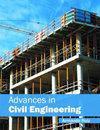Optimized Transverse–Longitudinal Hybrid Construction for Sustainable Design of Welded Steel Plate Girders
IF 1.6
4区 工程技术
Q3 CONSTRUCTION & BUILDING TECHNOLOGY
引用次数: 0
Abstract
I-section girders with different types of steel in the flanges and web (fyf > fyw, respectively) are known as transverse hybrid girders. These have proven to be more economical than their homogeneous counterparts. However, the use of hybrid configurations in the longitudinal direction of the element has yet to be studied. This paper uses optimization techniques to explore the possibility of constructing transverse and longitudinally hybrid (TLH) steel girders. The optimization objective is to minimize the manufacturing cost, including seven activities besides the material cost. The geometrically double symmetric I-girder design subjected to a uniform transverse load is performed using Eurocode 3 specifications. Nine case studies are implemented, varying the element span (L) and the applied load. The results show that establishing various configurations along the length of the element is beneficial. The optimum number of transition points is six, meaning the girder will have four configurations, i.e., one central and three others symmetrically distributed toward each half of the element. The optimum position for the first transition would be at (L/2), the second at (L/2), and the third at (L/2). The optimum extreme configuration is usually homogeneous (fyf = fyw = 235 MPa). The others increase the steel quality in the plates, maintaining hybrid arrangements to reach the central one that usually remains with S700 steel for the flanges and S355 for the web. The study shows that TLH configurations are more effective for elements with larger spans. By applying the formulated design recommendations in a different case study, the manufacturing cost dropped by over 50% compared to the traditionally designed element and by more than 10% relative to the optimized element with a homogeneous configuration. The study’s limitations and encouraging results suggest future lines of research in this area.优化横向-纵向混合结构,实现焊接钢板梁的可持续设计
翼缘板和腹板(分别为 fyf > fyw)采用不同类型钢材的工字钢被称为横向混合梁。事实证明,这种结构比同质结构更经济。然而,在构件的纵向上使用混合构型还有待研究。本文采用优化技术来探索建造横向和纵向混合(TLH)钢梁的可能性。优化目标是使制造成本最小化,包括材料成本以外的七项活动。采用 Eurocode 3 规范对承受均匀横向荷载的几何双对称工字钢梁进行了设计。通过改变构件跨度(L)和施加载荷,进行了九项案例研究。结果表明,沿构件长度方向建立各种配置是有益的。过渡点的最佳数量为六个,这意味着大梁将有四种配置,即一个中心配置和三个对称分布于构件两半的其他配置。第一个过渡点的最佳位置为 (L/2),第二个过渡点的最佳位置为 (L/2),第三个过渡点的最佳位置为 (L/2)。最佳极端配置通常是均匀的(fyf = fyw = 235 MPa)。其他配置提高了钢板的质量,保持了混合配置,以达到中心配置,通常翼缘采用 S700 钢,腹板采用 S355 钢。研究表明,TLH 结构对跨度较大的构件更为有效。通过在不同的案例研究中应用所制定的设计建议,与传统设计的构件相比,制造成本降低了 50%以上,与采用均匀配置的优化构件相比,制造成本降低了 10%以上。这项研究的局限性和令人鼓舞的结果为该领域未来的研究方向提出了建议。
本文章由计算机程序翻译,如有差异,请以英文原文为准。
求助全文
约1分钟内获得全文
求助全文
来源期刊

Advances in Civil Engineering
Engineering-Civil and Structural Engineering
CiteScore
4.00
自引率
5.60%
发文量
612
审稿时长
15 weeks
期刊介绍:
Advances in Civil Engineering publishes papers in all areas of civil engineering. The journal welcomes submissions across a range of disciplines, and publishes both theoretical and practical studies. Contributions from academia and from industry are equally encouraged.
Subject areas include (but are by no means limited to):
-Structural mechanics and engineering-
Structural design and construction management-
Structural analysis and computational mechanics-
Construction technology and implementation-
Construction materials design and engineering-
Highway and transport engineering-
Bridge and tunnel engineering-
Municipal and urban engineering-
Coastal, harbour and offshore engineering--
Geotechnical and earthquake engineering
Engineering for water, waste, energy, and environmental applications-
Hydraulic engineering and fluid mechanics-
Surveying, monitoring, and control systems in construction-
Health and safety in a civil engineering setting.
Advances in Civil Engineering also publishes focused review articles that examine the state of the art, identify emerging trends, and suggest future directions for developing fields.
 求助内容:
求助内容: 应助结果提醒方式:
应助结果提醒方式:


